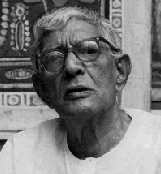
Jamini Roy
1887-1972
Jamini Roy was born on 11th April, 1887 into a moderately prosperous family of landowners in Beliatore village of the Bankura district, West Bengal.
Jamini was sixteen when he was sent to study at the Government College of Art, Kolkata, where he received his Diploma in Fine Art in 1908. He was taught to paint in the prevailing academic tradition of drawing classical nudes and painting in oils. However, he soon realised that he needed to draw inspiration, from his own culture rather than western traditions; hence he looked to the surrounding folk and tribal art for inspiration. He was most influenced by the Kalighat Pat, the popular market paintings that were sold outside the Kalighat temples in Kolkata. Moving away from his earlier impressionist landscapes and portraits, between 1921 and 1924, he began his first period of experimentation with the Santhal dance as his starting point. Jamini discarded the conventional practice of painting on canvases and started painting on materials like cloth, mats and even wood coated with lime. He also started experimenting with natural colors and pigments derived from mud, chalk powder and flowers instead of European paints. Roy changed style from his academic Western training, and created a new style based on Bengali folk traditions.
His underlying quest was threefold: to capture the essence of simplicity embodied in the life of the folk people; to make art accessible to a wider section of people; and to give Indian art its own identity. Jamini Roy's paintings were put on exhibition for the first time in the British India Street of Calcutta (Kolkata) in 1938. During the 1940s his popularity reached new highs, with the Bengali middle class and the European community becoming his main clientele. In 1946, his work was exhibited in London and in 1953, in the New York City. He was awarded the Padma Bhushan in 1954.
Jamini Roy died in 1972. He has four sons and a daughter (daughters-in-law and grand children and their children), his successors who live in Kolkata.
His works have been exhibited extensively in international exhibitions and auctions, they can be found in many private and public collections such as the Victoria and Albert Museum, London, the Lalit Kala Akademi in Delhi as well as museums in Germany and USA.
In 1976, the Archaeological Survey of India, Ministry of Culture, Govt. of India declared his works among the ‘Nine Masters’, whose work will be henceforth considered ‘art treasures, having regard to their artistic and aesthetic value.'

